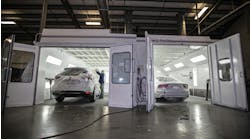Executing OEM certification program standards on the shop floor
The general goals of an OEM certification program are to deliver consistent crash-worthy repairs as intended by the OEM, while delivering an exceptional customer experience that results in customer brand loyalty. Within these standards, I have held many conversations with OEMs and shop operators on how to consistently do this on the shop floor.
As a shop operator, you invest in certification programs, you focus on education, you tool up the shop, you research the repair, you build a repair plan, you even send around a QC checklist. But are you confident in the final product you are delivering each and every time?
Quality in this industry has largely been a buzz word. I don’t know any shops that come out and say they do not do quality work. Quality needs to be real. It needs to be verified, validated and documented on the shop floor within the repair process. A post-repair audit, as many shops do before the vehicle is delivered, does not allow you to see what was done during the various repair stages in the shop. Taking an in-process approach is important for all repairs but is heightened within an OEM certification program. By being a member of these programs, you are setting yourself apart and attesting that you have the expertise to do that repair properly, even when you are dealing with other stakeholders such as insurers. You as the shop operator are responsible for how that repair was completed. So, what kind of visibility do you have?
I have seen many shops deal with issues because a technician took it upon themselves to make decisions inconsistent with the repair plan. I have also seen shops that I would consider great shops unknowingly let something slip by within the hurry of daily activity. In these cases, when reputation, money and safety are on the line none of the stakeholders in that repair win.
Depending solely on OEM program resources may not get the result you wish. Common practice in many programs is the random audit of repairs. The issue is that auditing perhaps 5 percent of the repairs completed each year does not provide a sample large enough to be confident in a quality process.
It is time for this industry to move past a paper quality control checklist that focuses on just a few key standard operating procedures (SOPs). The future is real time mobile communication of OEM repair procedures, auditing both by repair order line item and shop SOPs and the in-process verification, validation and documentation of the repair.
The great news is technology is moving this way. The ability to connect the various data streams and enable use on the shop floor via mobile devices makes this type of quality management and measurement possible.
Other benefits exist around continuous improvement. If you can identify the common failures and the way they were resolved you can begin to focus on the needed training, tooling and coaching to prevent them from happening. This can lead to better labor optimization. In our research we have found that internal redoes related to quality represent up to a 20 percent constraint in labor production. This means if you are a shop doing $2,000,000 annually in revenue, with available work you could be missing out on $40,000 in additional sales. This happens because the average rectify time of a redo is 1.25 clock hours. Those hours are spent redoing work that you have previously billed, so you miss out on the new billing hours you would have generated with the technician efficiency added. This happens more often than many realize. To clarify, here are some common quality failures to consider:
Paint related – color, dirt, runs, appearance
Body work – filler, gaps, function, welds
Mechanical – fault codes, alignment, windows, lights
Parts defects – wrong, damaged, missing
Detail and delivery – dirt, dust, compound, trash water spots
It’s time to carefully consider the quality process within your shop as it increases in importance to your business optimization and your ability to meet expectations of stakeholders like OEMs.





